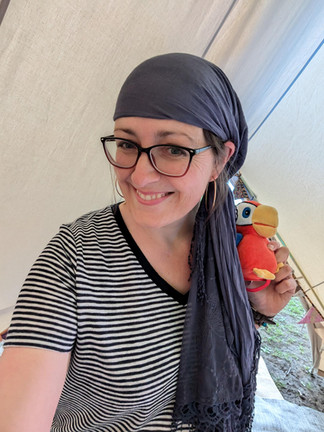- Attie Lime
- Jun 24, 2024
- 3 min read

I spent last Saturday morning in a tent, dressed as a pirate, talking to children about treasure (and dinosaurs in pyjamas).
I've been lucky enough to work at several festivals now, and this was a special one - a free city-centre event with a swashbuckling pirate theme! Special also, because I was invited after a recommendation following a festival appearance elsewhere, earlier in the year.
I was one of the 'artists' in the story tent. My sessions involved sharing poems, then exploring the imaginative opportunities provided by a treasure chest stuffed full of curious delights. There were diamonds, emeralds, shells, gold coins, buttons, a colourful scarf, a wooden goblet, jewellery, a bone, a feather, a crab claw, and more...
The children at my first session were quite taken in by my joining-in poems, and giggled wonderfully as I read (I could have gone home right then and felt happy that I had spread some poetry love!). My son said how much he enjoyed hearing them tell me the poems were "really good!". After plenty of hands-on time with the treasure, they chose to write their own poems, using the word board to help them, plus chat with me and each other along the way. They were determined to fill up the paper, coming up with idea after idea. I asked questions to get them thinking, and they explored their thoughts verbally before writing them down. I wish I had taken photos of their brilliant poems.
There were more children for the second session, mostly very young. Unlike at a school visit, there's no knowing what age of children you'll get at something like this. They listened to some piratey poems, and joined in, but what they really wanted was to open the treasure chest they had spotted on the floor! So, I cut the performance element short and we dived in. What joy! Excited hands and faces and chatter.
A cowrie shell was passed around to hear the sea, and described as feeling "like a welly boot", with an underside "bumpier than a crocodile". We talked about birds and bones and crabs. We talked about sails and jewels and sea glass, and keys to pirate worlds! We talked about rum and poison, and pretended to pour pirate wine into a magical goblet. There was no real need to put any of this on paper, but they wanted to, and asked to write a poem each. And this is where the real joy of the morning happened for me: a girl with loads of bright, articulate speech, oozing ideas, but pre-writing. She carefully wrote three or four full lines of zigzag 'writing' (imagine those fine motor control sheets used for practice, with the zigzags to trace over), talking to herself as she did it, and telling me everything she had written, afterwards. Her dad poked his head into tent. "She's working so hard!" I said - she proudly held up her poem and he responded with a perfect "Will you read it to me when we get home?". Just magic.
And of course, there was Marjorie, who thoroughly enjoyed her role as Pirate's Parrot (and got plenty of tummy tickles from the children, as usual).
But the joy for me was those children - all of them - their sense of wonder and imagination. And all of that rich, wonderful, free-flowing TALK. What a privilege to be in a tent, dressed as a pirate, to experience that.















